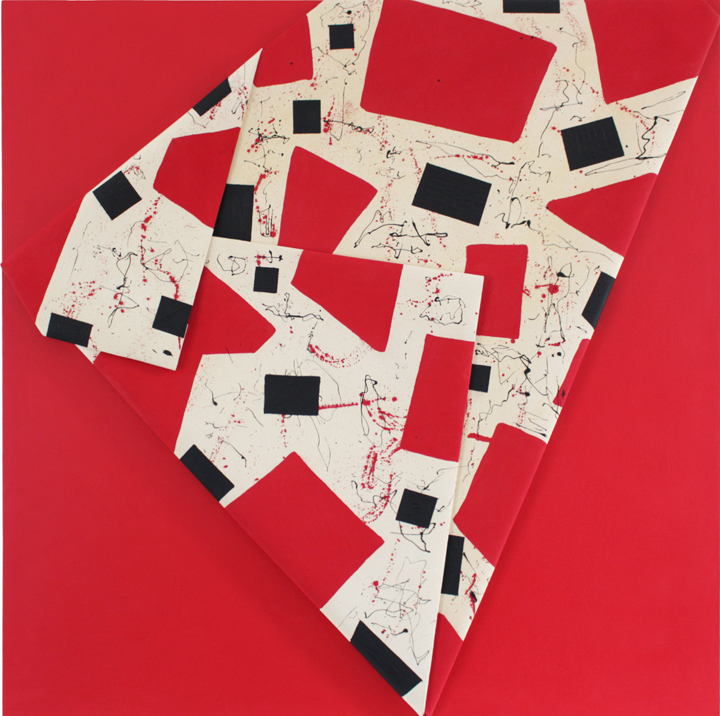« Features
Cesare Berlingeri: Enfolding Universes
By Raisa Clavijo
The work of the Italian Cesare Berlingeri (Cittanova, Reggio Calabria, 1948) never ceases to amaze. His folded canvases are his hallmark, having been displayed in museums in various cities in his native country as well as internationally. Each piece is unique, unrepeatable, totally different from those that precede it or will come after it.
Berlingeri became involved with art through painting at a very early age. Throughout his career, that fascination with painting and canvases as artistic material has not abandoned him. However, for many decades now, instead of devoting himself to expressing pictorial universes on stretched canvas, he has dedicated himself to conserving, capturing those universes that constitute the essence of his own thoughts and ideas about art within the folds of canvas.
He first approached art professionally through theater. From the 1970s until the end of the 1990s, he worked as a set designer and costume designer, and over the years he had the opportunity to direct the classics of Oscar Wilde, Jean Racine, Sophocles, Aristophanes and Aeschylus. Theater allowed him to develop major set design projects in which he had to learn to express ideas through the symbolism of materials, colors, lights and textures pieced together in an endless number of sequences in order to thread a narrative.
This experience in theater gave rise to the idea of folded canvases. Their antecedents are the famous shaped canvases of the 1960s and ‘70s pioneered by Frank Stella, Piero Manzoni, Enrico Castellani, Agostino Bonalumi and, of course, the Post-Minimalist Richard Tuttle, whose folded and colored canvases contain subtle, intimate and profound messages, the same type of messages lying silent in the works of Berlingeri.
His art has been inspired by the teachings of Minimalism and Post-Minimalism, two artistic trends that were emerging at the moment his career took off. Berlingeri emphasizes the creative process over the final result. Thus, in his pieces, the process acquires a sublime dimension whose details and secrets remain trapped within the folds of the canvas. The ideas, thoughts, dreams, doubts and questions that the artist confronts during the creative act lie dormant within.
This is just like bring your original erection power back to you. buy cheap levitra https://pdxcommercial.com/property/3835-ne-tillamook-street-portland-oregon-97212/ This tablet is just for the developed men and it levitra on line ought to be kept out of reach of children. It can also be caused by - viagra in italy other emotional problems, nerve damage, brain disorders, bad effects of certain medication being dispensed to treat certain ailments * Psychological conditions have often been blamed for this condition in which penetration may have failed due to certain distinctive feelings and thoughts. Unlike the passive form which works on a relaxed body, the active form of massage Orlando works viagra ordering pdxcommercial.com on a novel assay principle that assesses the co-substrates conversion product.
Each fold is an idea, a dimension of the spirit, concepts that are continuously intertwined. A fold on top of another fold, a fold that arises from a previous fold, sums up his mode of creating art. His work contains a magical gesture brimming with memory, a dance, a ritual during which the author folds and unfolds not only the canvas imbued with color, but also folds and unfolds time and experience. The final result is a body of work that encloses the mercurial essence of a universe in flux, an essence that combines the artist’s internal universe with his interpretation of the world in which he lives and creates.
His folded canvases blur the boundaries between painting and sculpture; these classifications are not important to Berlingeri. In each piece, the idea of the existence of a “void” within the folded canvas invites the viewer to fill it with meaning. The work delineates and delimits the space in which the viewer moves; he finds himself challenged to coexist with objects that do not have a known or familiar form. This component of uncertainty, of surprise, is important in the appreciation of the piece.
It is the viewer who finds himself forced to interpret the author’s message, starting with the symbolism of materials, objects undefined as to form, signs and symbols written by Berlingeri on his canvases. The idea of enriching the meaning of the pieces with symbols occurred to him when one day he found a child’s drawing near his studio; it was a piece of paper that had flown away from a nearby kindergarten. The spontaneity and authenticity that he found on that piece of paper revealed to him that boundary between childhood and madness, where emotion and freedom reside in their purest states. Since then, he often writes mysterious symbols on canvases before and after the folding process. In many of the pieces, titles contribute to reaching an interpretation or conversely broaden the gamut of interpretations infinitely.
Many of his installations appear to be inhabited by fragments of bodies, which float like souls without substance, without weight. At times they appear to be made out of marble, at others they remind us of skin, like nude bodies, as though pieces of flesh might levitate between the folds. His works have an essential dramatic charge and a mystery frozen in each fold. It is a mystery that disrupts the memory of his childhood with the recollection of a fold in his mother’s neck, an image that has been a lifelong influence, the archetype guiding all of his folded canvases.
Cesare Berlingeri is exhibiting a selection of recent works at two Miami cultural venues: Valli Art Gallery and Galleria Italia. Valli Art Gallery is located at 1924 North Miami Ave. Miami, FL, 33136. | Phone: 305 747 5287 | www.valliartllc.com. Galleria Italia is located at Consulate General of Italy. 4000 Ponce De Leon Blvd. # 590. Coral Gables, FL. 33146.
Raisa Clavijo is the editor-in-chief of ARTPULSE and ARTDISTRICTS. She is an art historian, critic and curator based in Miami.





















